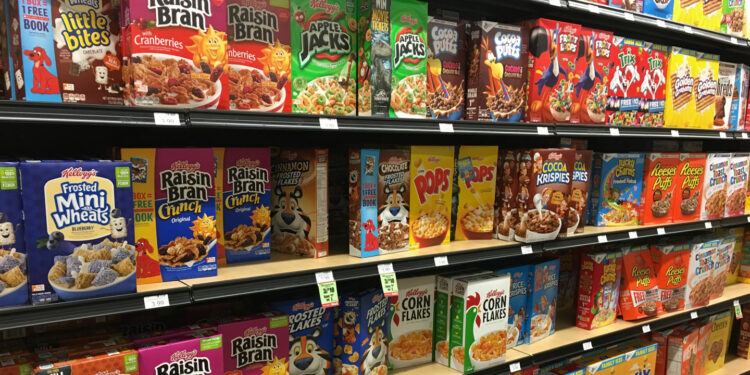The topic of synthetic food coloring and its association with behavioral concerns in children is gaining significant attention.
Recently, California’s Governor Gavin Newsom enacted the California School Food Safety Act, which will prohibit public schools in the state from offering or selling foods that contain six specific synthetic dyes starting in 2028. Just this month, demonstrations erupted outside the Battle Creek headquarters of WK Kellogg Co. in Michigan as activists criticized the company’s failure to remove these dyes from their U.S. products, including breakfast cereals.
Share Your Experience with Science News
Help us enhance our services by participating in our 15-question reader survey.
Interestingly, although these dyes are banned within California schools, they remain permitted by the U.S. Food and Drug Administration (FDA). The FDA continues to stand firm on its position that there is insufficient evidence linking synthetic dyes with disorders such as ADHD and hyperactivity.
The range of products containing synthetic food colorings is extensive, yet determining a child’s risk when consuming these items poses a real challenge. Divergences between state regulations and federal guidelines complicate efforts to identify which foods should be avoided due to dye content.
Even though conclusive evidence connecting these substances to neurobehavioral problems remains sparse, experts suggest that certain children may be more vulnerable than others. Advocates for safety emphasize that California’s legislation aims to protect public school students whilst potentially motivating additional states toward similar policies—ultimately pressuring food producers to rethink their formulations.
“This initiative serves as an excellent starting point because schools represent environments where focus is essential,” remarks Melanie Benesh from the Environmental Working Group based in Washington D.C., an organization instrumental in supporting California’s School Food Safety Act. “It cultivates a more conducive learning atmosphere for all.”
As discussions around this issue intensify nationwide, Science News investigates how we’ve arrived at this pivotal moment regarding synthetic food dyes and what science reveals about them.
Understanding Synthetic Food Dyes
Synthetic colors are additives designed specifically to enhance visual appeal—their unique molecular structures allow specific wavelengths of light absorption resulting in vibrant hues that elevate otherwise dull fare. Their primary purpose seems superficial; they do not extend shelf life or contribute nutritional benefits; rather they solely act as lures for consumers.
“Many items featuring these products include candies and cereals marketed towards younger audiences,” notes Benesh. The application of synthetic coloration makes snacks visually appealing while inadvertently boosting sales.”
Common Foods That Contain Synthetic Dyes
In the United States, there are no specific warning labels indicating whether foods contain artificial coloring agents; thus consumers usually must peruse ingredient lists painstakingly to identify potentially harmful additives themselves. When included within a product’s ingredients list—as found under color descriptions followed by numerical designations like “Blue 1”—synthetic dyes can easily go unnoticed without meticulous examination.
If you’re monitoring your child’s intake for such additives here are some common supermarket items you might want watch closely:
- Baked goods: cake mixes, sugar cookies,muffins
- Snacks: Pop-Tarts,Cheetos ,and various dried fruit packages
- Candies: M&M’s ,Skittles,and Wax Bottles
- Cereals: Froot Loops,Trix,and Lucky Charms
- Beverages: like Powerade or sports drinks targeting youth demographics
Synthetic food colorings aren’t exclusively found only within edible products—some cosmetics,hair care treatments,and even pharmaceuticals also utilize these now-banned ingredients throughout their formulations .
When Did Concerns Around Synthetic Dyes Arise?
A troubling history surrounds synthetic coloration techniques dating back centuries when lead chromate , arsenic utilizations emerged alongside coal tar derivatives leading early users into perilous situations across both nineteenth-twentieth century timelines . A particularly dangerous incident occurred during Halloween festivities inthe1950’s whereby numerous children reported illnesses after ingesting candy infused recklessly using Orange1 dye (Scientific American published results on August 12th).
During approximately same period five out aforementioned six colors undergoing prohibition currently received approval statusfromtheFDA circa1931.. However potential hazards remained largely overlooked until growing suspicions arose during late1970s attributing childhood hyperactivity issues directlytofoodcoloradditives according Mari Golub developmental neurotoxicologist at UniversityCalifornia.Davis.With growing case studies surfacing surrounding connections made between consumption behavior trends reflected were subsequently coupled together alongside research tackling regulatory barriers imposed upon hormone alterations linkedalongsidetheFAIrules
But some scientists contend correlations can’t entirely dismiss validity either ! An increasing numberofclinicalprojects conducted over previous decades aligning various pieces observational findings examining dietary data pertaining newcomers returning intriguing patterns associations noted having negative repercussions such behaviors resonated often decried.[TheUCLADepartmentPublicHealth releasedarticle elucidatingissuein2006.]
I think it would beneficial actively push awareness campaigns dispelling any misinformation consumed circulating aboutartificialdye impacts,specifically acknowledgingconsumers need informed safely across all spectrums urgently align messaging accurately througheducation,purelybasedupon reputableresources -Mark Miller pediatric physician focused environmental health @Oakland office along MathMissidepath assessing gradual advancements despite long arising historical debates concerning multi-phased trials.







